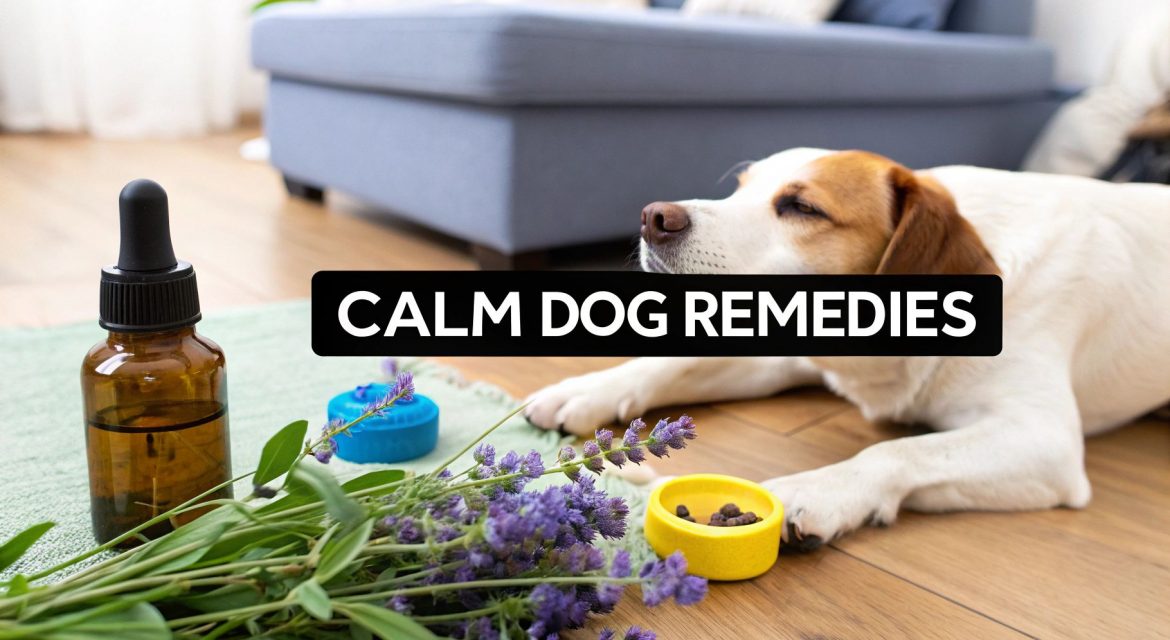It’s absolutely heartbreaking to see our best friends struggle with anxiety, isn’t it? We know that familiar pacing, the relentless whining during a thunderstorm, or the sad eyes that follow you to the door when you pick up your keys. As loving dog owners, we share that worry and feel a deep responsibility to help them find peace. You’re not alone in this journey, and seeking solutions shows just how much you care.
The good news is that supporting your dog doesn’t always require an immediate jump to prescription medications. Together, we can explore a world of gentle, effective dog anxiety natural remedies that can make a genuine difference in your companion’s life. This comprehensive guide is designed to empower you with the knowledge needed to make informed choices for your furry family member.
In this listicle, we’ll delve into seven trusted options, from calming herbs like Valerian Root to the comforting pressure of a Thundershirt. We will break down what each remedy is, how it works, and provide practical tips on how to safely introduce it into your dog’s routine. We’ll cover everything you need, offering clear, actionable insights to help your companion feel secure, confident, and understood. Let’s start this path towards a calmer life, together.
1. CBD Oil (Cannabidiol)
One of the most discussed and researched dog anxiety natural remedies is Cannabidiol, or CBD oil. Derived from the hemp plant, CBD is a non-psychoactive compound, meaning it won’t make your dog “high.” Instead, it works by interacting with your dog’s endocannabinoid system, a complex network of receptors that helps regulate mood, sleep, and stress responses, promoting a state of calm and balance.
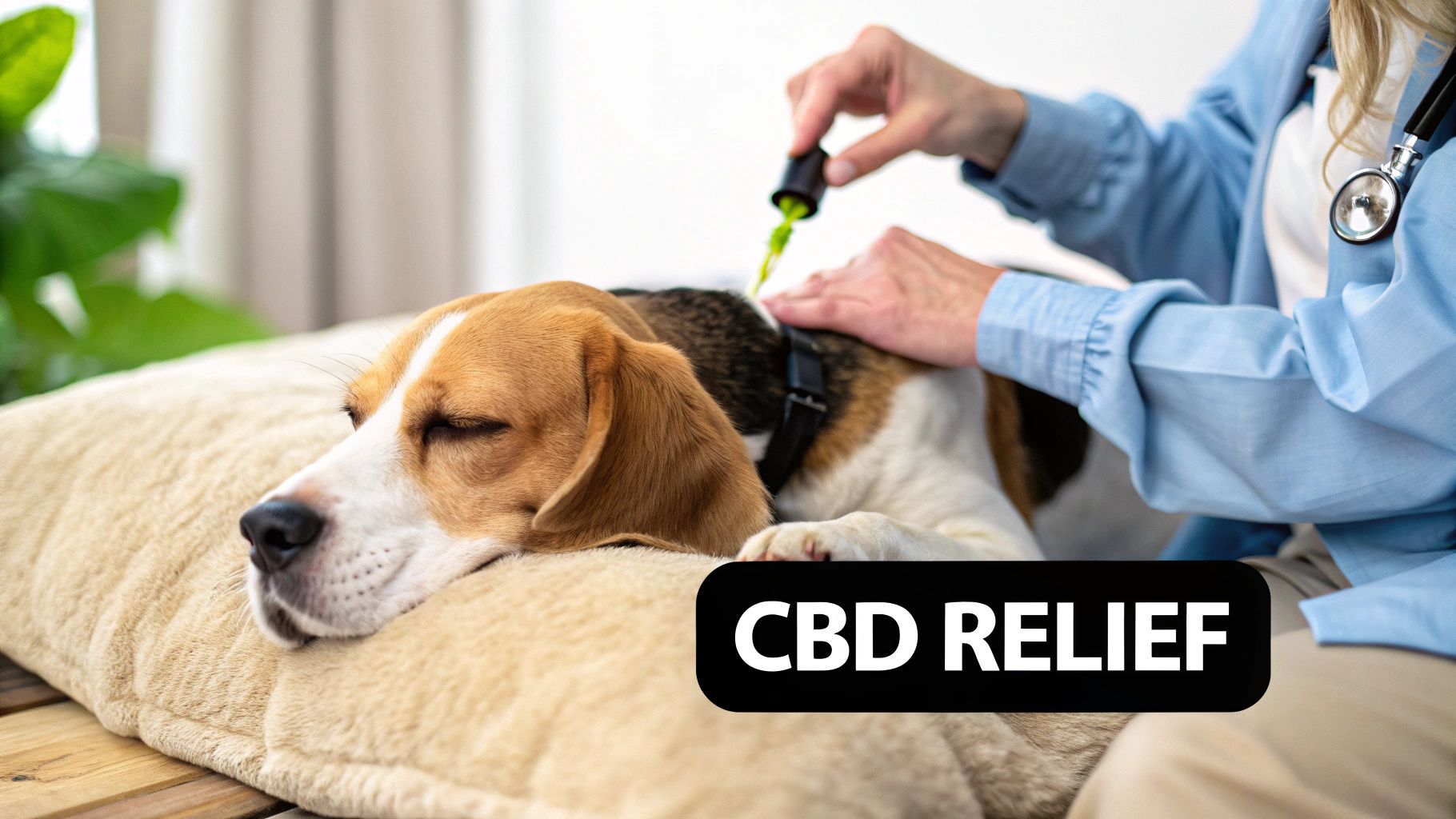
For many of us, seeing our companion struggle with constant pacing, panting, or destructive behaviour is heartbreaking. CBD offers a gentle yet effective way to manage these symptoms. We’ve seen promising results in case studies and heard anecdotal reports from fellow owners, like a rescue dog with a severe noise phobia being able to calmly rest through a fireworks display after a pre-event dose of CBD oil.
How to Use CBD Oil for Your Dog
If you’re considering CBD, it’s so important to approach it thoughtfully to ensure your dog’s safety and achieve the best results. The key is to start with a low dose and gradually increase it based on how your dog responds.
Actionable Tips for Implementation:
- Start Low and Go Slow: A common starting point is around 0.2mg of CBD per pound of your dog’s body weight, administered twice daily. For example, a 20lb (approx. 9kg) dog would start with 4mg of CBD per dose.
- Choose Full-Spectrum Products: We recommend opting for full-spectrum or broad-spectrum CBD oil over CBD isolate. These products contain other beneficial plant compounds that work together in what’s known as the “entourage effect,” potentially enhancing the oil’s calming properties.
- Time It Right: For situational anxiety, like car journeys or vet visits, give your dog their dose about 30-60 minutes before the stressful event. For generalised anxiety, consistent twice-daily dosing is often more effective.
- Verify Quality: Always look for a Certificate of Analysis (COA) from a third-party lab. This document confirms the product is free from harmful contaminants and contains the advertised amount of CBD.
Important Note: Before introducing any new supplement, it’s essential that we consult our veterinarian. They can help you determine the right approach, especially if your dog is already taking other medications, to ensure there are no adverse interactions.
2. Calming Music and Sound Therapy
Another powerful and accessible dog anxiety natural remedy is the use of calming music and sound therapy. This approach uses psychoacoustic principles, employing specific frequencies and tempos designed to reduce stress hormones and encourage relaxation. It works by creating a soothing audio environment that can mask startling noises and naturally calm your dog’s nervous system, offering a gentle solution to anxiety.
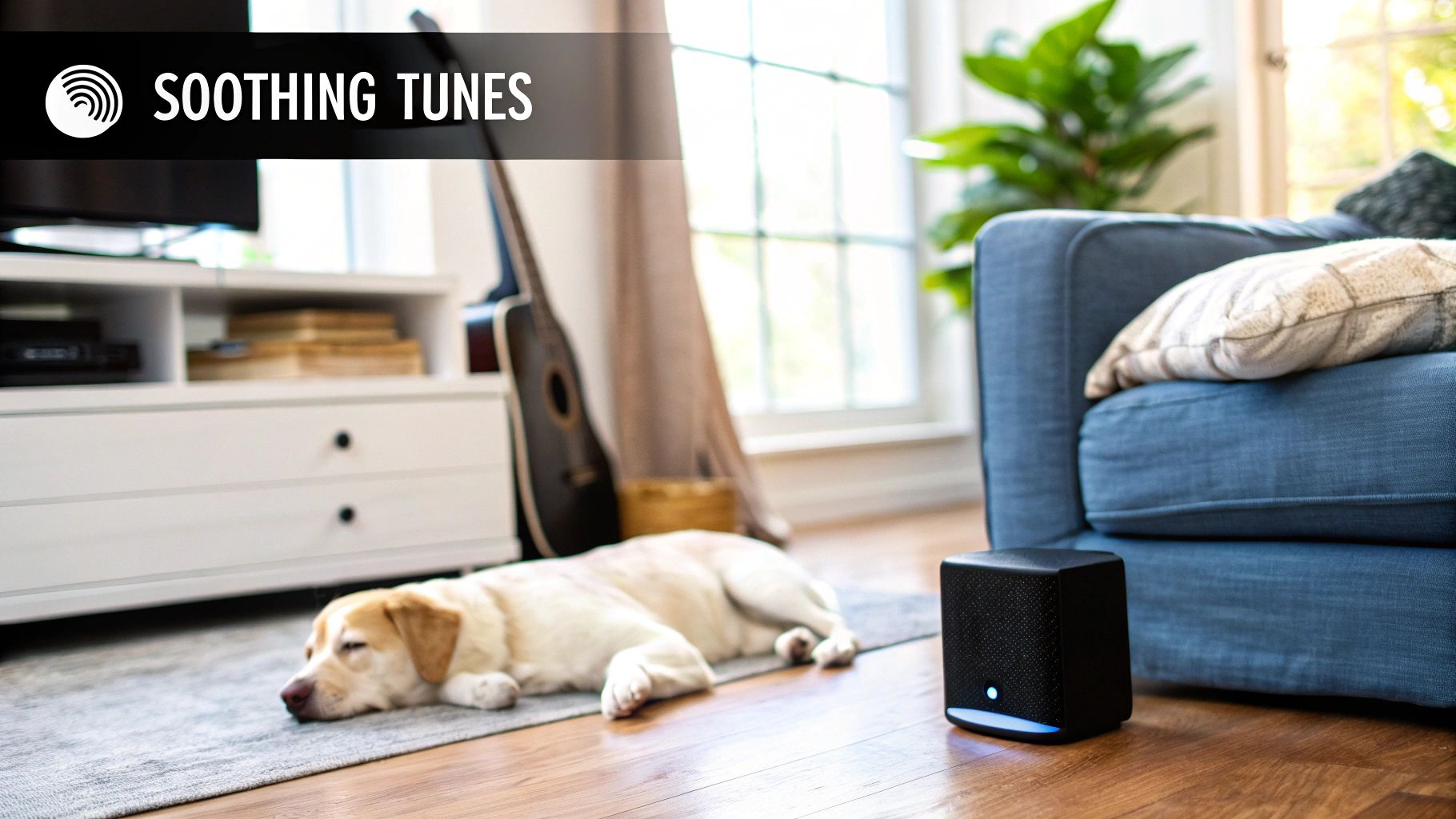
It can be so distressing to watch your dog react to loud noises like thunderstorms or fireworks. Sound therapy provides a simple, non-invasive way to manage these fears. For instance, studies conducted in animal shelters using the Through a Dog’s Ear music programme showed a significant reduction in kennel stress. Similarly, many of us have found our once-fearful dogs remaining completely calm during storms when a specially designed playlist is on.
How to Use Calming Music for Your Dog
Integrating sound therapy into your dog’s routine is straightforward, but a few key steps can make it much more effective. The goal is for us to create a predictable and comforting auditory backdrop that your dog learns to associate with safety and relaxation.
Actionable Tips for Implementation:
- Prepare in Advance: For predictable stressors like a planned car journey or an approaching storm, start playing the calming music 15-30 minutes beforehand to get your dog into a relaxed state.
- Keep the Volume Moderate: Your dog’s hearing is much more sensitive than ours. Music that is too loud can increase anxiety rather than soothe it, so keep the volume at a comfortable, low-to-moderate level.
- Create Positive Associations: Play the music during calm, happy times, such as when you’re giving them a treat or having a quiet cuddle. This helps your dog associate the sounds with positive feelings, strengthening their calming effect during stressful moments.
- Experiment with Sounds: While classical music is often effective, some dogs respond better to nature sounds, white noise, or audiobooks. See what your companion prefers.
- Combine with Other Techniques: Music therapy works wonderfully alongside other calming methods. Using it while your dog is in their safe space or during a gentle massage can amplify the benefits and is a great way of building confidence in dogs.
Important Note: While sound therapy is very safe, it’s important to observe your dog’s reaction. If they seem more agitated, try a different type of sound or a lower volume. Every dog is an individual, and finding what works best for them is key to success.
3. Adaptogenic Herbs (Ashwagandha, Rhodiola, Holy Basil)
Turning to the plant kingdom offers another powerful set of dog anxiety natural remedies: adaptogenic herbs. These are unique plants that help the body adapt to stress by supporting the adrenal glands and balancing cortisol levels. Instead of sedating your dog, herbs like Ashwagandha, Rhodiola, and Holy Basil work to build your dog’s resilience over time, helping them manage anxiety triggers more effectively.
This approach focuses on restoring balance rather than just masking symptoms. Think of it as strengthening your dog’s emotional foundation. For example, holistic veterinarians have reported cases where an anxious Border Collie showed a significant reduction in separation distress after six weeks of ashwagandha supplementation, or a rescue dog with PTSD-like behaviours regained confidence when rhodiola was combined with behavioural training.
How to Use Adaptogenic Herbs for Your Dog
Incorporating adaptogens requires a patient and observant approach, as their effects are cumulative and build up over several weeks. Correct dosing and product selection are vital for safety and effectiveness.
Actionable Tips for Implementation:
- Start with a Half Dose: Adaptogens can be potent. Let’s begin with half the manufacturer’s recommended dose for your dog’s weight and gradually increase to the full amount over a week or two, monitoring for any changes.
- Serve with Food: Always administer these herbs with a meal. This helps to improve absorption and minimises the risk of any potential stomach upset for your companion.
- Choose High-Quality Products: We suggest opting for organic, third-party tested herbal supplements specifically formulated for dogs. This ensures the product is pure, potent, and free from harmful additives.
- Be Patient: Unlike pharmaceuticals, adaptogens don’t work instantly. You should allow at least 4-6 weeks of consistent use to see the full therapeutic benefits and a noticeable shift in your dog’s anxious behaviours.
Important Note: We always need to consult with a holistic or integrative veterinarian before adding any herbal remedies to our dog’s routine. They can provide guidance on the correct herb, dosage, and ensure it won’t interfere with any existing health conditions or medications.
4. Aromatherapy with Lavender and Chamomile
Harnessing the power of scent is another effective approach among dog anxiety natural remedies. Aromatherapy involves using essential oils and plant extracts to promote psychological and physical well-being. The scents of lavender and chamomile, in particular, are known to directly impact a dog’s limbic system (the emotional centre of the brain) through their olfactory receptors, helping to reduce stress and encourage relaxation.
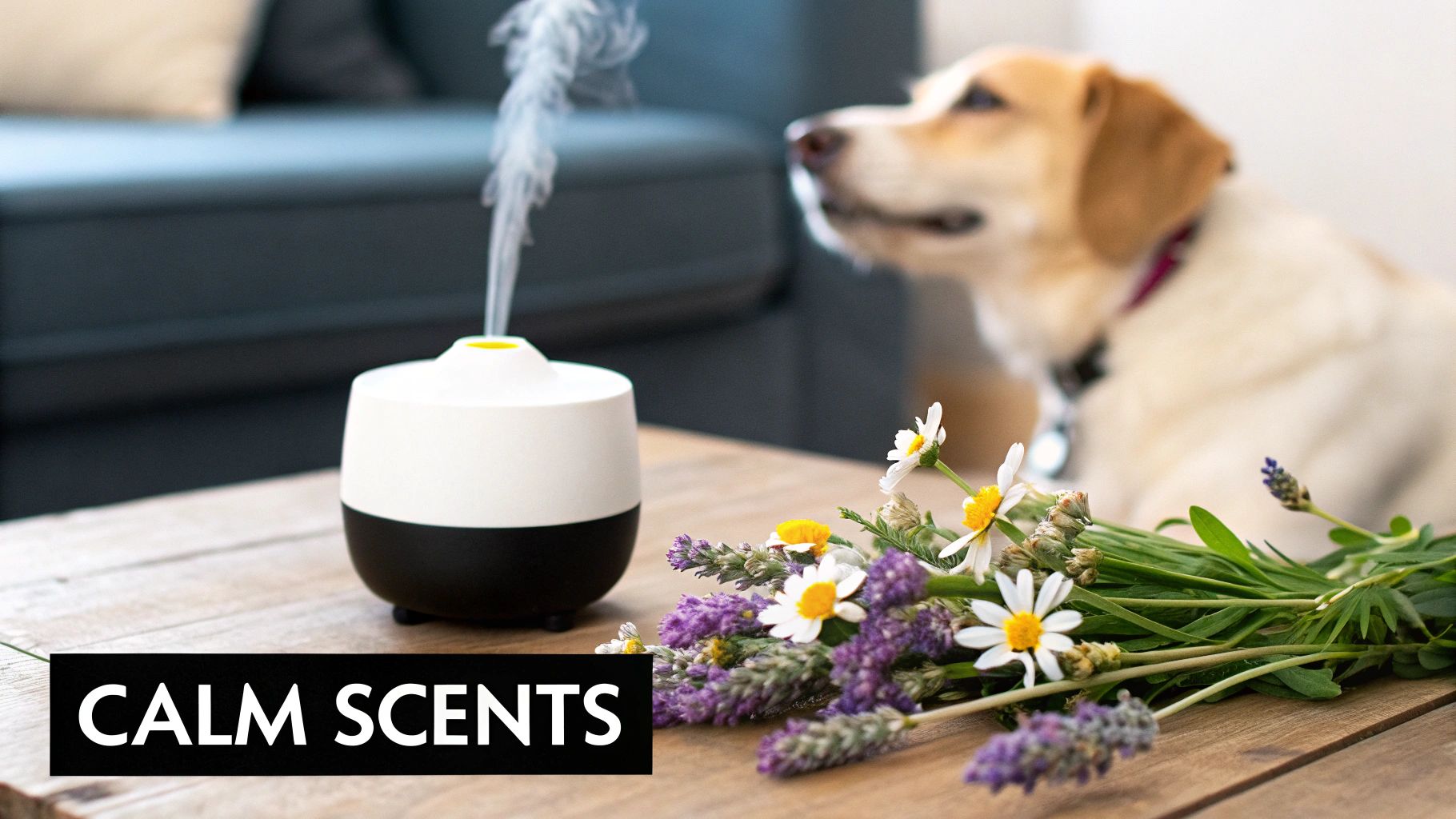
This gentle method offers a passive way to create a calming environment for your anxious companion. For example, some veterinary clinics have successfully reduced pre-surgery anxiety in dogs by using lavender diffusers in their waiting areas. Similarly, an anxious rescue dog might learn to self-soothe by seeking out bedding that has been lightly spritzed with a diluted chamomile solution.
How to Use Aromatherapy for Your Dog
Properly introducing aromatherapy is key to ensuring it’s a positive and safe experience for your pet. Since a dog’s sense of smell is incredibly powerful, a little goes a long way, and dilution is non-negotiable.
Actionable Tips for Implementation:
- Always Dilute: Never apply pure essential oils directly to your dog’s skin or fur. We must dilute them heavily with a carrier oil like coconut or jojoba oil, or simply use a water-based diffuser.
- Choose High-Quality Oils: Let’s opt for 100% pure, therapeutic-grade essential oils from reputable sources. Synthetic fragrances can be irritating and lack therapeutic benefits. For readers interested in the botanical source of this calming scent, you can further explore different types of lavender plants to understand their properties.
- Provide an Escape Route: When using a diffuser, place it in an area where your dog can easily move away if they find the scent overwhelming. Their comfort is always our top priority.
- Use Intermittently: To prevent your dog from becoming desensitised to the scent, use aromatherapy for short periods (e.g., 30-60 minutes) during stressful times rather than running a diffuser all day.
Important Note: Always introduce new scents gradually and observe your dog for any signs of irritation or aversion, such as sneezing, drooling, or rubbing their face. If you have other pets, like cats or birds, be aware that some essential oils can be toxic to them. A chat with your vet is always a good first step.
5. L-Theanine Supplementation
L-Theanine is another powerful amino acid on our list of dog anxiety natural remedies. Naturally found in green tea leaves, this compound promotes a state of calm relaxation without causing drowsiness. It works by increasing alpha brain waves, which are associated with a state of “wakeful rest,” and helps to balance key neurotransmitters like GABA, dopamine, and serotonin, which regulate mood and anxiety.
For dogs who need to manage their anxiety while remaining alert and responsive, L-Theanine is an excellent choice. We’ve seen remarkable stories, such as a highly reactive dog being able to calmly participate in training classes after supplementation, or a senior dog with cognitive dysfunction finding more restful sleep. This makes it a versatile tool for managing everything from situational stress to more persistent, generalised anxiety.
How to Use L-Theanine for Your Dog
Incorporating L-Theanine into your dog’s routine can be straightforward and effective, but it’s important for us to get the dosage and timing right to see the best results. A methodical approach ensures your companion gets the support they need when they need it most.
Actionable Tips for Implementation:
- Dose Correctly: A good starting point is between 2-4mg per pound of your dog’s body weight. For instance, a 25lb (approx. 11kg) dog might start with a dose of 50-100mg.
- Time for the Situation: For acute, predictable stressors like thunderstorms or visitors, administer the supplement 30-60 minutes before the event begins. For ongoing anxiety, a consistent twice-daily dose with meals is often more beneficial.
- Consider Combination Formulas: L-Theanine is often found in calming supplements like Solliquin or Composure Pro, where it’s combined with other calming agents like taurine or tryptophan. This synergistic effect can enhance its overall effectiveness.
- Observe and Adjust: Pay close attention to your dog’s behaviour after starting the supplement. You can adjust the dosage within the recommended range based on their response to find what works best for them. For a deeper understanding of supplementation, you can learn more about dog health and care.
Important Note: Always have a conversation with your veterinarian before introducing a new supplement like L-Theanine. They can provide guidance on the correct dosage for your dog’s specific needs and ensure it won’t interfere with any existing health conditions or medications.
6. Thundershirt and Pressure Wraps
Among the most innovative dog anxiety natural remedies are pressure wraps, such as the well-known Thundershirt. This drug-free solution works on the principle of deep pressure therapy, similar to swaddling an infant or using a weighted blanket for humans. The wrap applies gentle, constant pressure to your dog’s torso, which can have a remarkable calming effect on their nervous system, helping to release soothing hormones and reduce anxiety.
The calming effect of these garments has been praised by animal behaviourists like Dr. Temple Grandin and Dr. Patricia McConnell for their ability to provide a sense of security during stressful situations. As a dog parent, seeing a Beagle with a firework phobia remain calm during a noisy celebration or a rescue dog gain confidence while wearing a wrap can be a huge relief, offering a simple yet effective tool for managing fear.
The following data chart illustrates the reported effectiveness of Thundershirts in reducing anxiety symptoms based on user surveys.
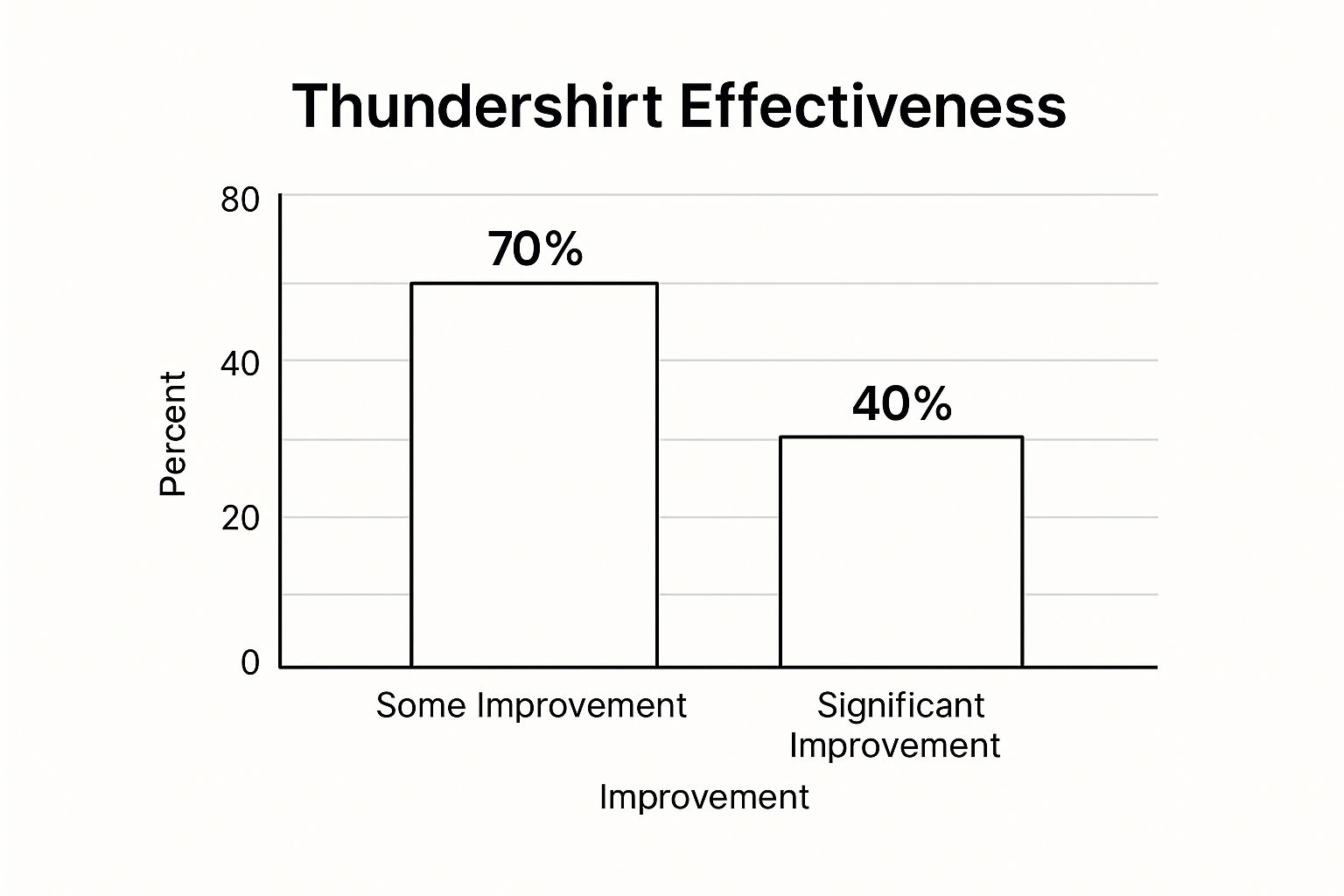
This data shows that a significant majority of us observe some level of improvement, confirming the value of pressure wraps as a calming aid.
How to Use a Thundershirt for Your Dog
To get the most out of a pressure wrap, it’s important to introduce it correctly and ensure a proper fit. Your dog’s comfort and positive association with the garment are key to its success.
Actionable Tips for Implementation:
- Introduce Gradually: Let’s not just put the wrap on during a thunderstorm. Introduce it during calm moments with treats and praise, letting your dog wear it for short periods to build a positive connection.
- Ensure a Snug Fit: The wrap should be snug but not restrictive. You should be able to comfortably slide two fingers between the wrap and your dog’s body. An improper fit can cause discomfort or be ineffective.
- Time It Right: For situational fears like storms or visitors, put the wrap on your dog before the anxiety begins. For separation anxiety, your dog can wear it during your departures.
- Monitor and Limit Use: Avoid leaving the wrap on for more than a few hours at a time, and never leave it on an unsupervised dog for extended periods, especially in warm weather, to prevent overheating.
Important Note: A Thundershirt is a management tool, not a cure. For dogs with severe anxiety, it works best when combined with other behavioural modification techniques. Effective training is crucial, and you can learn more about positive dog training methods here.
7. Valerian Root
Valerian root is a time-honoured herb that has been used for centuries as a gentle sedative and anxiolytic. This natural remedy works by increasing the levels of gamma-aminobutyric acid (GABA) in the brain, a neurotransmitter that helps inhibit nerve transmissions and calm nervous activity. For your anxious canine, this translates into a gentle sense of relaxation and a reduction in hyperactivity without disrupting their natural sleep cycles.
If you’re looking for a non-pharmaceutical way to help your dog cope with stress, valerian root is one of the most established dog anxiety natural remedies available. We’ve heard from fellow pet parents who found success using it to help an older dog with “sundowner syndrome” achieve better sleep quality, or to calm a dog during a long-distance car journey. It can offer a subtle yet effective way to ease tension and promote a state of well-being.
How to Use Valerian Root for Your Dog
Properly administering valerian root is key to its effectiveness and your dog’s safety. The goal is to provide a calming effect without over-sedating, and a careful, measured approach will help you find that perfect balance for your furry friend.
Actionable Tips for Implementation:
- Start with a Test Dose: Before regular use, give your dog a very small amount to check for any adverse or paradoxical reactions (hyperactivity).
- Choose Standardised Extracts: To ensure consistent potency and accurate dosing, we recommend opting for standardised extracts in liquid tincture, capsule, or powder form rather than whole dried root.
- Time the Dose: Administer valerian root approximately 30-60 minutes before a stressful event like a thunderstorm or vet visit to allow it to take effect.
- Mask the Odour: Valerian root has a very strong, earthy smell that many dogs dislike. Mix the powder or liquid form with a strong-smelling, tasty food like sardines or wet food to make it more palatable.
Important Note: Valerian should not be used in puppies, pregnant dogs, or alongside other sedatives or anaesthetics. Always consult with your veterinarian before introducing this or any new supplement to confirm it’s a suitable option for your dog’s specific health needs and to determine the correct dosage.
7 Natural Remedies for Dog Anxiety Comparison
| Item | Implementation Complexity 🔄 | Resource Requirements ⚡ | Expected Outcomes 📊 | Ideal Use Cases 💡 | Key Advantages ⭐ |
|---|---|---|---|---|---|
| CBD Oil (Cannabidiol) | Moderate – requires dosing, vet consultation | Moderate – costs vary, quality-dependent | Significant anxiety reduction; fast-acting | Separation anxiety, noise phobias, generalized anxiety | Scientifically backed; multiple dosing options; legal widely |
| Calming Music and Sound Therapy | Low – easy to implement, requires setup | Low – streaming or media, quality speakers needed | Moderate stress reduction, ongoing use needed | Noise phobias, shelter stress, veterinary visits | Non-invasive; low cost; benefits multiple pets simultaneously |
| Adaptogenic Herbs | Moderate – daily dosing, gradual build-up | Low to moderate – supplements, consistent use required | Gradual, long-term anxiety resilience | Chronic anxiety, immune support, combination therapies | Addresses root causes; safe long-term; additional health benefits |
| Aromatherapy with Lavender & Chamomile | Low – simple application, intermittent use | Low – essential oils, diffusers | Immediate but temporary calming effects | Situational anxiety, travel, environmental stress | Fast-acting; cost-effective; pleasant experience for owners |
| L-Theanine Supplementation | Moderate – dosing adjustments may be needed | Moderate – supplement purchase | Prompt calming without sedation | Anxiety requiring alertness, training, events | Non-sedating; safe; enhances other calming agents |
| Thundershirt and Pressure Wraps | Low to moderate – fitting required | Low to moderate – one-time purchase | Immediate relief for ~70% dogs | Noise phobias, separation anxiety, acute stress | Drug-free; immediate effect; reusable |
| Valerian Root | Moderate – dosing timing and observation | Low – widely available supplement | Mild sedation; short duration | Sedation needs, sleep support, short-term anxiety | Natural sedative; inexpensive; well-studied safety profile |
Creating a Brighter, Calmer Future for Your Best Friend
We’ve explored a powerful array of dog anxiety natural remedies, travelling through the science of CBD oil, the soothing frequencies of sound therapy, and the gentle embrace of a pressure wrap. From adaptogenic herbs like Ashwagandha to calming aromatherapy with lavender, you now possess a comprehensive toolkit designed to bring peace and comfort to your anxious companion. The journey to a calmer dog is not about finding a single magic solution; it’s about us creating a holistic, supportive environment tailored specifically to your dog’s unique personality and triggers.
The most important takeaway is that you are your dog’s greatest advocate and ally. Your observations, patience, and commitment are the most crucial ingredients for success. While L-Theanine and Valerian Root offer promising supplemental support, they work best when integrated into a foundation of trust, predictable routines, and positive reinforcement. Understanding the root of your dog’s anxiety is the first step, and applying these natural remedies is the compassionate follow-through.
Your Actionable Next Steps to a Calmer Canine
So, where do we go from here? The key is to start small and be consistent.
- Choose One and Observe: Select the one remedy from our list that you feel is the best fit for your dog’s situation. Perhaps it’s introducing calming music during alone time or trying a Thundershirt during the next thunderstorm.
- Consult Your Vet: Before you introduce any new supplement or herb, such as CBD oil, L-Theanine, or Valerian Root, it is essential to have a conversation with your veterinarian. They can provide guidance on appropriate dosages and ensure there are no conflicts with your dog’s existing health conditions or medications.
- Create a “Calmness Journal”: Keep a simple log to track your dog’s behaviour. Note the remedy used, the situation (e.g., leaving the house, car journey), and any changes you observe, no matter how small. This will help you identify what truly works.
Mastering these approaches is about more than just managing symptoms; it’s about deepening the incredible bond we share with our dogs. By proactively addressing their anxiety, you are telling them, in a language they can understand, that they are safe, secure, and deeply loved. You are not just alleviating their fear; you are building their confidence and resilience, creating a foundation for a happier, more peaceful life together. Every small step you take is a monumental victory in your dog’s world, reinforcing the trust they place in you. Your dedication today is shaping a brighter, calmer future for your best friend.
Ready to find the perfect, high-quality natural products to support your dog on their journey to calmness? Explore the curated selection at My Life My Dog, where we’ve sourced the very best in dog anxiety natural remedies and wellness aids. Visit My Life My Dog to discover vet-approved solutions that will help your companion live their best, most relaxed life.


